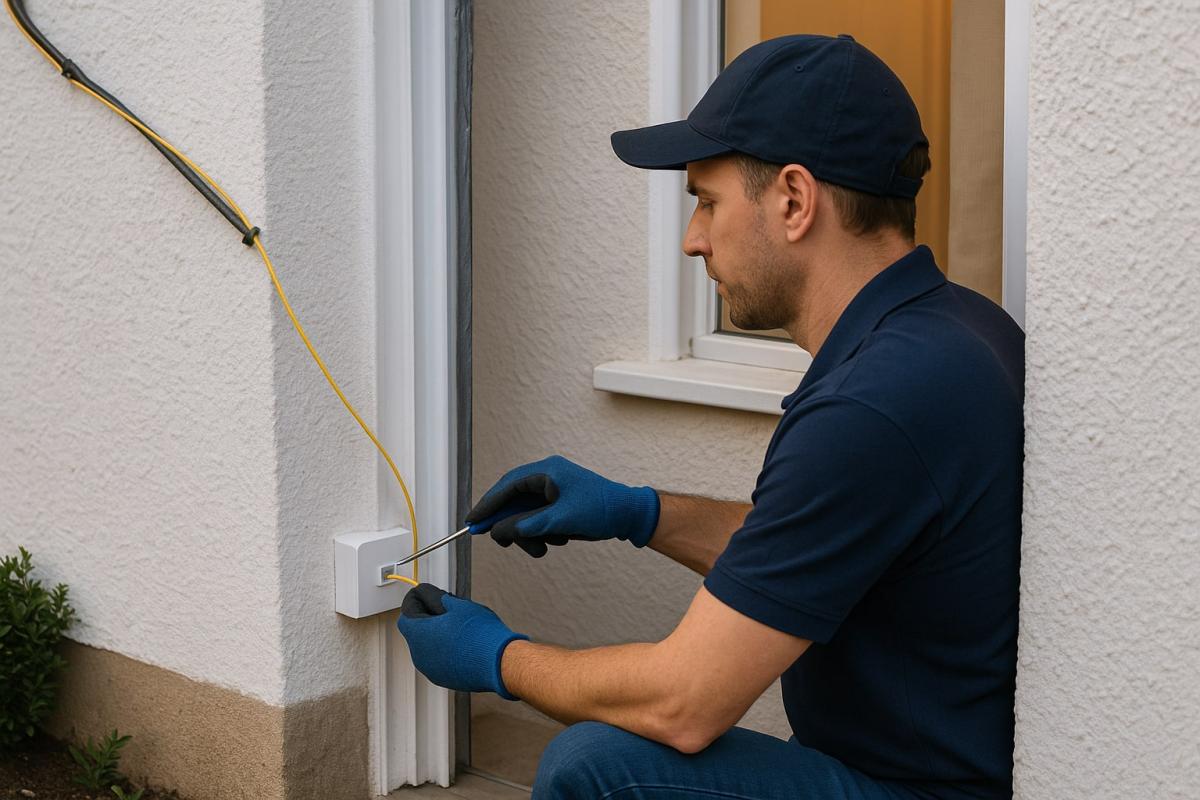Fast and stable connection is a basic necessity in every household today. The solution is fiber optic internet, which works differently than regular cables and offers greater reliability to users. We'll explain how this technology works in practice, what it entails to run a fiber optic cable to your home, and what equipment you’ll need to keep everything running smoothly.

The internet in households has come a long way in the past few decades. In the 1990s, we connected to the network via dial-up lines, which blocked the phone and could only transfer a small amount of data. Over time, ADSL and other forms of connection over copper cables arrived, offering higher speeds but still encountering their limitations. Anyone who has experienced evening connection fluctuations or slow video uploading knows that older technologies have their weaknesses.
In response to the growing demands of households, fiber optic internet began to play a key role. It has become synonymous with stable connection and high speed, which regular cables cannot offer. Thanks to these characteristics, it becomes the most reliable way to have a connection at home that can be relied upon even under heavy load.
Today, optics represent the technology that sets the direction of internet development. If you're curious why it’s considered a step forward compared to traditional connection methods, let's take a closer look.
What is fiber optic internet?
Fiber optic internet is a type of connection that, instead of traditional copper cables, uses thin glass fibers. These do not transmit an electrical signal but light. Thanks to this, optics can transmit a vast amount of data over long distances without noticeable attenuation or interference. The result is a fast and stable connection that works reliably even under heavy load.
Unlike older technologies such as DSL or cable connections, the fiber optic network is not as susceptible to external influences. It is not afraid of moisture or surges during storms, making outages very rare. This is why optics have become the standard in backbone networks that connect entire countries and continents.
In households, metallic cables long dominated because they were easier to build. However, with the rising demand for speed and stability, optics have begun to reach more frequently into apartments and family homes. Today, it is among the most reliable solutions if you're looking for internet that can handle work, entertainment, and smart home operations.
How does fiber optic internet work in practice?
In practice, much depends on how far the fiber optic cable is extended. If it ends directly in your household, you get a stable connection with the lowest latency. But if the cable ends earlier and the last part is resolved with different wiring, the quality may not be perfect.
Depending on where it terminates, various types of fiber optic connection are distinguished:
- FTTN (Fiber To The Node) – the cable ends at a node several kilometers away, and the rest of the journey uses another cable.
- FTTC (Fiber To The Curb/Cabinet) – the cable is extended to a distributor near the house, and the last section to the household uses different wiring.
- FTTB (Fiber To The Building) – the cable ends in a building, and older cabling leads to individual apartments.
- FTTH (Fiber To The Home) – the best option where the cable goes directly into the household.
For the connection to work correctly, suitable end equipment is needed. Most commonly, it is a router for the fiber optic cable, which connects to the optical outlet and distributes the internet throughout the household, either via cables or using Wi-Fi. In some cases, there's an optical network terminal (ONT) between the outlet and the router, which works similarly to a modem for fiber optic internet. It converts the light signal from the fiber into a data signal that the router can work with.
Thanks to this, you get a connection with low latency, high stability, and the ability to handle situations where multiple devices are connected to the network simultaneously.
Installation of fiber optic cable into a house or apartment
If you've understood what fiber optic internet is, you are probably interested in the installation itself. The first step is to verify availability. The provider will determine based on your address whether a fiber optic network already runs in the area and what connection options are available.
If optics are available, technicians bring a cable from the street or common areas in an apartment building to the household. It ends with a small optical outlet, most often installed in the living room or study.
This outlet then connects to a router for the fiber optic cable, which distributes the internet throughout the home via cables and Wi-Fi.
The installation itself usually takes only a few hours. For family homes, it may involve drilling through a wall and routing the cable from outside to inside. In apartment buildings, risers or common spaces are mostly used, so the intervention is generally smaller.
The installation conditions vary depending on the provider. Basic installation might be free of charge in some places, while others may require a small fee. If more complex construction work is needed, the cost is higher, but it depends on the specific situation.

How to choose the right provider?
Choosing the right provider is key to getting the most out of fiber optic internet. It's not enough to look at just the price or the stated speed. It's important to know what real connection quality you can expect at your address. Therefore, it's worth checking not only availability but also the experiences of other users in the area.
Ask whether the connection remains stable even during peak times when the network is most loaded, and what the average latency values are. Technical support also plays a role. A reliable provider should respond quickly to potential problems and offer clear service conditions.
Consider the future needs of the household. The fiber optic network has the potential to handle much more than we use today, from high-definition streaming to online learning and remote work, to running smart devices. A provider investing in the development of its infrastructure will ensure you're prepared for new services that will come in the future years.
The future of connection is optical
The development of internet infrastructure is heading towards optics becoming a common part of every household. While it used to be the privilege of big cities or new builds, it is gradually being built in smaller areas. Transitioning from older technologies is an investment in long-term reliability. One of the greatest advantages is that the optical fiber has virtually unlimited capacity and can transmit data in the range of tens of gigabits per second.
In the future, it's expected that having a fiber optic cable installed in your home will be as standard as electricity or water supply. Such a solution ensures stability, resistance to external influences, and preparedness for services that will require even higher speeds than today. If you're looking for long-term reliable connectivity, optics is a technology you can rely on for years to come.
Cloud gaming – the end of consoles in sight?

Cloud gaming allows you to play games from anywhere without the need for expensive hardware. In this article, you'll learn how game streaming works, what advantages and limitations it brings, and which services are leading the way today. And most importantly: can it really threaten traditional consoles?
Chips under the skin and in the head. The future is closer than we think

Brain microchips already allow controlling a computer with mere thoughts. In the article, you will learn how they work, what they have brought to the first users, and what promises scientists and Elon Musk associate with them. Along with hopes, questions about safety, ethics, and where this technology might take us also arise.
What consumes the most data on mobile? YouTube, Spotify, Netflix and other apps under scrutiny

Mobile data usage can sometimes be unpleasantly surprising. The most are consumed by video streaming and music services – how much data does YouTube, Netflix or Spotify use? And what about other apps like social networks, maps or video calls? Check out the overview of the biggest data guzzlers and find out how to keep mobile data under control.
How to find out who is connected to your Wi-Fi – and can you easily disconnect them?

Is your internet slowing down or do you suspect that someone unauthorized is connected to your Wi-Fi? We advise you on how to find out who is connected to your Wi-Fi, and what to do if you find an intruder.
Artificial intelligence is not omnipotent. Where does the human still have the advantage?

Artificial intelligence can write articles, analyze data, and generate videos. However, there are skills and professions that this technology cannot (yet) replace. In the article, we will look at where humans still have the upper hand, why AI needs human supervision, and which abilities will become increasingly valuable to develop in the digital world.
What internet speed is sufficient? Comparison for streaming, gaming, work, and TV

Does your video keep buffering or game lag, even though you pay for 'fast internet'? Perhaps you simply don't have the right one for what you do at home. What internet speed do you need for watching TV, streaming movies, working from home, or online gaming? Find a clear comparison in the article.